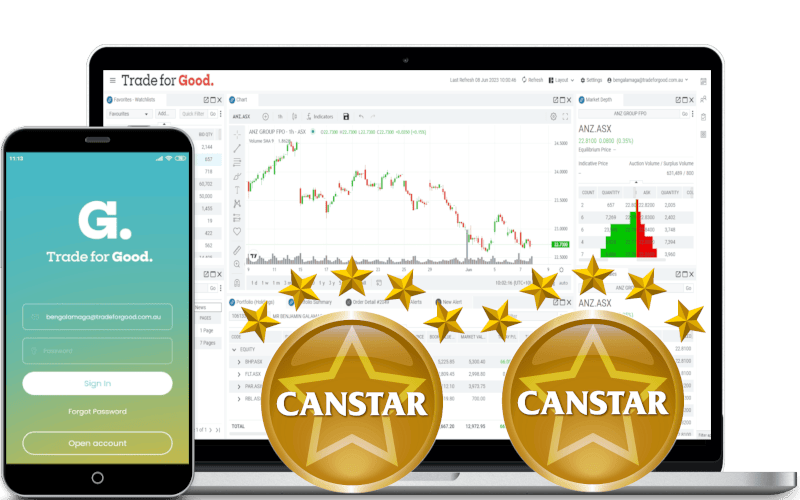ChatGPT prompts for investors

ChatGPT or any AI research platform (Claude, Kimi, Deepseek)—how can I use it for research in my online share trading?
AI can do so much that it can feel overwhelming, but with the right guidance, you can focus on what matters most, helping you make informed and confident investment decisions. Please be aware that the data provided by AI platforms, despite using the best prompts, is limited to what’s available in their training data.
Here are 10 carefully designed prompts to help you with your investing journey.
How do the prompts work?
Each prompt works as a separate task that you are asking it to research. The more you structure the prompt, the more you can focus it on the information you want to learn.
Here are the prompts:
#Context: Who is doing the analysis, and what are you trying to identify?
#Goal: What are you trying to achieve?
#Prompt: What actions need to be taken
Anything in [ ….. ], you will need to specify, e.g.
- Market: [Insert market type, e.g., ASX, Minerals, Banking]
- Timeframe: [Optional: Specify the period, e.g., last 6 months]
#Output: how do you want the result displayed to you

What does it look like?
I did this in https://chatgpt.com
I updated the prompts for Market and Timeframe
• Market: [ASX, Rare Earth Minerals]
• Timeframe: [last 12 months]
Then click on the button to run the prompt.

#Context: You are an experienced financial analyst. Your task is to identify current trends in a specific market and explain how they might impact investment opportunities.
#Goal: Provide an analysis of the latest market trends and their potential effects on investments.
#Prompt:
• Market: [ASX, Rare Earth Minerals]
• Timeframe: [last 12 months]
• Highlight 3-5 key trends in the market
• Explain how these trends could affect investments positively or negatively
• Suggest potential opportunities or risks based on the analysis.
#Output: A summary of market trends with actionable insights for investors. Act as a buy side.

Once it has completed the research and generated a response, you can read or export it.
Here are the 10 prompts I have created that you can use.
- Latest Market Trends
- Create a Diversified Portfolio
- Compare Asset Classes
- Develop a Passive Income Strategy
- Business Breakdown Prompt
- Growth Stage and Capital Allocation
- Financial Quality Deep Dive Prompt
- Growth Drivers Prompt
- Valuation Concept Prompt
- Identify and Mitigate Risks

Latest Market Trends
#Context: You are an experienced financial analyst. Your task is to identify current trends in a specific market and explain how they might impact investment opportunities.
#Goal: Provide an analysis of the latest market trends and their potential effects on investments.
#Prompt:
- Market: [Insert market type, e.g., ASX, Minerals, Banking]
- Timeframe: [Optional: Specify the period, e.g., last 6 months]
- Highlight 3-5 key trends in the market
- Explain how these trends could affect investments positively or negatively
- Suggest potential opportunities or risks based on the analysis
#Output: A summary of market trends with actionable insights for investors. Act as a buy side.

Create a Diversified Portfolio
#Context: You are an investment strategist. Your task is to design a diversified portfolio based on the user’s risk tolerance and financial goals.
#Prompt:
- Risk tolerance: [Low, medium, or high]
- Investment horizon: [Short-term, medium-term, or long-term]
- Market: [Insert market type, e.g., ASX, Minerals, Banking]
- Budget: [Optional: Specify the total amount to invest]
- Suggest a mix of investments [e.g., stocks, bonds, ETFs]
- Provide a percentage allocation for each asset class
- Explain the reasoning behind the allocation
#Output: A portfolio plan with detailed asset allocations and rationale

Compare Asset Classes
#Context: You are a financial consultant. Your task is to compare different types of investments and provide insights into their benefits and risks
#Goal: Help the user understand which asset class might be the best fit for their goals
#Prompt:
- Asset classes: [Insert options, e.g., stocks vs. real estate, etf vs stock, etf vs gold etc ]
- Goals: [Optional: Specify financial objectives, e.g., income generation, capital growth]
#Response Guidelines:
- Compare the pros and cons of each asset class
- Highlight potential risks and returns
- Recommend which asset class aligns better with the user’s goals
#Output: A comparison of the selected asset classes with a clear recommendation

Develop a Passive Income Strategy
#Context: You are an investment advisor. Your task is to create a strategy for generating steady passive income through investments.
#Goal: Design a plan that includes various income-generating investments suitable for the user’s risk tolerance and goals
#Prompt:
- Budget: [Insert available budget]
- Risk tolerance: [Low, medium, or high]
- Investment horizon: [Optional: Specify short-term or long-term]
#Response Guidelines:
- Suggest income-generating options [e.g., dividend stocks]
- Provide a percentage allocation for each option
- Explain how the investments generate passive income
#Output: A clear passive income strategy with actionable steps

Business Breakdown Prompt
This captures the essentials: what the company does, who it serves, and how it generates income—all at an analyst level.
#Context: Act as a buy-side equity analyst. Analyse [Company Name] [Ticker] and explain
#Prompt: Core business model in plain English
- Main products/services
- Customer segments
- Key geographies
- Primary competitors and how this company is different
#Output: Keep it concise but specific, like an internal research note

Growth Stage and Capital Allocation
This indicates the company’s developmental phase and whether management is reinvesting for growth or rewarding shareholders with distributions.
#Context: Act as a buy-side equity analyst.
#Prompt: Which growth stage is [Company Name] [Ticker] in (early growth, scaling, mature compounder, or ex-growth/cash cow)?
Justify your answer using:
- 3-5 revenue and eps growth
- Free cash flow trends
- Net cash or net debt
- Dividends, buybacks and reinvestment (R&D/capex)
#Output: Explain how management is allocating capital and whether it fits the stage.

Financial Quality Deep Dive Prompt
This gauges the durability and quality of the company’s earnings power, looking beyond surface-level revenue movements.
#Context: You are a financial analyst. Your task is to deep dive into the company’s earnings power, looking to the future, beyond the surface-level revenue
#Prompt: Summarize the financial quality of [Company Name] ([Ticker]) over the last 5-10 years. Focus on:
- Revenue CGAR
- Operating margin trend
- Free cash flow per share trend
- ROIC and ROE vs their cost of capital
#Output: Balance sheet strength (leverage, interest cover)
Then give 1-10 score for:
- Growth
- Profitability
- balance sheet
- and consistency,
- with 1-2 sentences justifying each score

Growth Drivers Prompt
This identifies the catalysts that could boost share price performance and the risks that might prove your thesis wrong.
#Context: You are a financial analyst. Your job is to identify things that could boost share price performance and their associated risks.
#Prompt: List the top 3-5 growth drivers for [Company Name] over the next 3-5 years and the top 3-5 risks.
For each growth driver and risk, include:
- Impact (Low/Medium/High)
- Profitability (Low/Medium/High)
- The main lending indicators an investor should track (metrics, news or industry data).
#Output: End with a short paragraph on what would need to go right for this to be a multi-year winner – and what would make you sell.

Valuation Concept Prompt
This assesses whether the current price represents value or reflects overvaluation when measured against the last three years.
#Context: You are a financial analyst. You need to assess if the current price represents value or overvaluation, compared to the last 3 financial years.
#Prompt: Evaluate the valuation of [Company Name] [Ticker] today.
Compare its current P/E, EVEBITDA, P/S, and P/B to:
- Its own 5-10 year averages and
- 3-5 close peers
- Explain whether the current multiple implies optimism, pessimism, or something in line with history
#Output: Build a simple 3-year bear/base/bull scenario with revenue growth, margin assumptions, and an implied fair value range for the stock. Summarise whether the risk/reward looks attractive, neutral, or poor for a long-term investor.

Identify and Mitigate Risks
#Context: You are a risk management consultant. Your task is to identify potential risks in an investment and suggest strategies to minimize them
#Goal: Provide a list of risks associated with the investment and actionable steps to mitigate them
#Prompt:
- Investment type: [Insert type, e.g., stocks, etf’s]
- Market: [ASX]
#Response Guidelines:
- List 3-5 potential risks associated with the investment
- Suggest practical strategies to reduce or eliminate each risk
- Recommend tools or resources for ongoing risk management
#Output: A list of risks and solutions to help manage the investment effectively

The Bottom Line
AI is a fantastic tool for online trading; it handles much of the heavy lifting—scanning the internet, digesting information, and presenting it clearly. However, the issue is that the source of information may not always be accurate. When possible, verify where the sources come from or seek access to credible data providers.
Go and try these or create your own prompts and leverage what AI can do for you.

What you learn here has been used in our Trade for Good software.
Click on the button to find our software education videos.
You can read more of our educational articles in the Trade for Good Learn section
Trade for Good Learn

